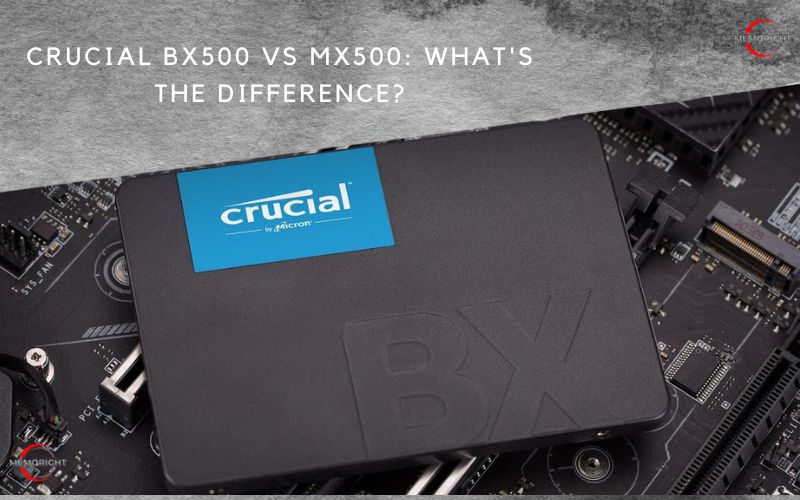The Crucial BX500 vs MX500 are two of the most popular solid-state drives on the market. Both drives offer fast performance and excellent value for money. However, there are some key differences between the two drives.
In this article, Memoright will be comparing two types of SSDs (solid state drives) from the brand Crucial, the MX500 and BX500. SSDs are faster and more reliable than traditional hard drives, and Crucial is a leader in the field. We’ll go over the key specs and features of each type of SSD, including capacity, performance, price, warranty, and more.
This will help you decide which is the best option for your needs.
Overview of Crucial BX500 and MX500
MX500
The Crucial MX500 has been on the market a little longer than the BX500. This SSD is of great quality and is accelerated by Micron’s 3D NAND technology for high speed and security to match.
The Crucial MX500 SSD is available in both 2.5 inches and M.2 2280 form factors and comes with four different storage capacities up to 2TB. The MX500 is well-rated by gamers for its excellent durability and performance, which matches some of the higher-end brands in terms of quality, but boasts a lower price point.
BX500
The BX500 is the successor to Crucial’s popular BX300 line of SSDs. Compared with the Crucial MX series, the Crucial BX line offers streamlined, no-frills SSDs and are designed with low-budget buyers in mind, with a lower price to match the lightweight package.
This SSD is great for everyday, universal use, and is accessible for a range of budgets and computing needs. The BX500 comes with 6GB/s or SATA III interface options and is available in a 2.5-inch form factor. The Crucial BX500 SSD is also available in five different capacities, ranging up to a maximum of 2TB.
Crucial BX500 vs MX500: What Are the Differences?
Form Factor and Interface
As you can see in the sample image above, Crucial MX500 and BX500 appear exactly like any regular 2.5 drives; however, they use another look here. The large brother MX that premiered before sports this silver instance while the BX version gets the black case with a reclining print onto the surface seeing its version name.
They’re coming inside this 7mm size that’s frequently utilized in laptops, but it would appear that the MX500 will provide you the bracket too for the setup that requires a heftier profile.
Capacity
When deciding on a hard disk or a solid-state drive, hard disk capacity is an essential aspect to be considered because it allows you to save files.
Crucial BX500 includes five different capacities, yet Crucial MX500 has four unique capabilities. Both of them can reach up to 2TB.
So, as for Crucial MX500 in BX500, there’s not any difference inability. But Crucial BX500 provides more options, and you may pick anyone according to your real needs.
Performance
When deciding on a hard disk or a solid-state driveway, the operation would be among the most crucial variables to be considered. An SSD with excellent performance may empower your computer to run faster and improve PC performance.
| Crucial BX500 SSD 1TB | Crucial MX500 SSD 1TB | |
| Sequential Read | 540MB/s | 560MB/s |
| Sequential Write | 540MB/s | 510MB/s |
| Random Read | N/A | 95,000 IOPS |
| Random Write | N/A | 90,000 IOPS |
All numbers are from Crucial’s official website; however, the random read and write rate of Crucial BX500 SSD aren’t mentioned. In the above graph, you can realize that the Crucial MX500 SSD 1TB is a bit quicker than the Crucial BX500 SSD 1TB, but we believe they’re not much different.
Additionally, you may even decide to check the disc performance on your own via the Disk Benchmark characteristic of MiniTool Partition Wizard.
If you want to boost the computer performance or increase the storage size of the computer, you can use these two Crucial SSDs to replace the original one.
Reliability and Warranty
When buying from a trusted brand such as Micron you know you’ll get a good warranty, which makes it worth paying that little bit extra to know you’re covered if something goes wrong. The MX500 comes with a five-year limited warranty, whereas the BX500 is covered by a three-year warranty.
With both SSD models, you’ll also have Crucial’s expert customer service on hand via phone, chat, email, or their community forum, to answer any questions you may have.
Price
The last difference between Crucial BX500 and Crucial MX500 we want to mention is the price. The budget is always the key factor when selecting a suitable hard drive or SSD.
According to the Crucial official site, the Crucial BX500 SSD 1TB is about $99.99 and the Crucial MX500 1TB is about $114.99. One thing you need to know is that the price of an SSD may vary due to the different capacities. In general, the larger SSD is, the more expensive it is.
So, from the above part, you can know some differences between BX500 and MX500 SSD. Of course, besides the above, they also have some other differences. But after reading the above part, you may have general information about what their differences are and which one is better.
As far as I can see, the Crucial MX500 SSD may be better than the Crucial BX500 SSD. Besides, when selecting the SSD, you also need to check the interface of your computer and choose the suitable one.
Which One Should You Buy?
These two SSDs aren’t all that different on the outside, and to be honest, they aren’t all that different on the inside.
The MX500 is available in an M.2 form factor, which offers an even quicker connection and improved responsiveness. The BX500, on the other hand, has a greater range of capacity options, from 120 GB to 2TB, to accommodate various budgets and storage needs.
Thanks to the Micron 3D NAND technology, which improves processing rates, loading times, and battery life, all SSDs are highly regarded and operate superbly.
The BX500 isn’t significantly slower than the MX500, which has a little faster sequential read and write speed. The MX500 stands out for its superior security features that safeguard your data and provide you additional piece of mind, as well as its incredibly silent operation—you won’t even know it’s there.
Although the BX500 is allegedly intended to be a little more economical than its predecessor, there is not much of a price difference between these two SSDs. Although the MX500 costs a little more for the 1TB, you also receive a 5-year warranty as opposed to a 3-year warranty. Thus you might end up saving money in the long term.
Because the MX500 and BX500 are so comparable in terms of price and performance, you have a choice between spending a little bit more for slightly improved read and write speeds and a longer warranty or spending less and skipping a few minor features but still getting a good deal overall.
How to Migrate System to Crucial BX500 or Crucial MX500 SSD?
You can use the Crucial BX500 SSD or Crucial MX500 SSD in place of the factory-installed hard drive to improve PC performance. You can choose to migrate the system from HDD to SSD to accomplish that.
You can use a clone tool to copy the OS from an HDD to an SSD.
Therefore, it is advised to use the expert SSD clone software MiniTool ShadowMaker, which enables you to upgrade hard drives without losing data.
A professional Windows backup tool called MiniTool ShadowMaker also lets you back up your operating system as well as disks, partitions, files, and folders. However, you must first attach the Crucial SSD to the PC.
- Download MiniTool ShadowMaker from the following button, and install and launch it.
- Click Keep Trial.
- Click Connect in This Computer to enter its main interface.
- After entering its main interface, go to the Tools page.
- Then choose Clone Disk.
- Next, click the Source module to select the disk clone source. If you want to clone the system disk, select it as the clone source. Then click Finish.
- Click Destination module to choose a target disk. Here, you should choose Crucial BX500 SSD or Crucial MX500 SSD as the target disk. Then click Finish.
- Then you will receive a warning message which tells you all data on the target disk will be destroyed during the cloning process. If there are important files on it, back up them first.
- Then the disk cloning process will begin. Do not interrupt the cloning process until it is finished.
When the disk cloning process is finished, you will receive a warning message which tells you that the original disk and the target disk have the same signature and either of them will be marked as offline. So, you can remove or disconnect the original HDD. In addition, if you want to boot your computer from the target disk, you can enter BIOS to change the boot order.
Once all steps are finished, you have successfully cloned the system to the Crucial MX500 SSD or Crucial BX500 SSD.
FAQs
Which is faster, MX500 or BX500?
The MX500 has a great advantage of speed and consistency because of its SLC cache.
Is the MX500 still good?
A great choice for an older computer, the Crucial MX500 offers good performance, useful software, a five-year warranty, and hardware encryption support for a decent price.
Does MX500 have DRAM?
Compared to the BX-500 series, the MX500 SSD provides an entirely different build. It starts with the massive DRAM cache and Silicon Motion 2258. Like a lot of current SATA solutions, the MX500 reaches the top of the 6Gbps mountain at 500MB/s read.
Conclusion
In conclusion, this post has demonstrated the distinctions between the Crucial MX500 and BX500 in 5 areas. It’s easy to suggest the Crucial MX500 since it performs well despite the wide range of alternatives available. However, since the BX500 does not meet the current standard, we also find it challenging to achieve the same thing with it, even though the cost difference between the two is not as significant.










